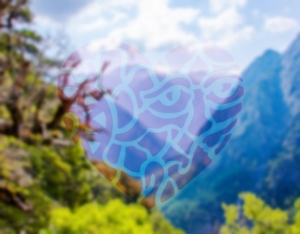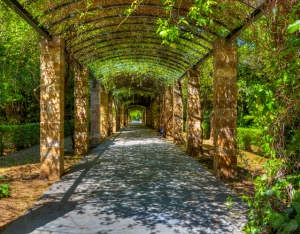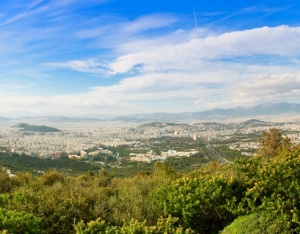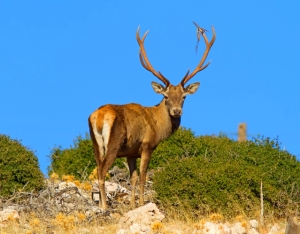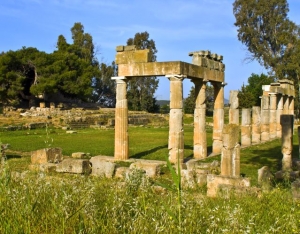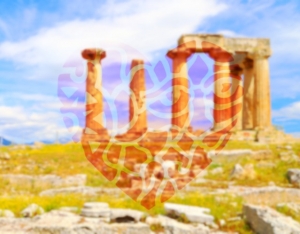Thodoris Bgenopoulos
Pedion tou Areos is one of the largest parks in Athens, approximately 1 km from Omonia Square.
It is an area of 230 acres, being an important green lung amidst one of the most densely populated areas of Athens. Already from the time of King Otto, Pedion tou Areos was a place of recreation and amusement for the Athenians. But, in 1927 it is decided to be renovated, having as prototype the National Garden. The works that begun in 1934, aimed to shape a new park and honor the fighters of the Greek Revolution of 1821. So the visitor today, walking the main street of the park, can admire the busts of heroes who excelled in the Greek struggle against the Turks. Theodoros Kolokotronis, Georgios Karaiskakis, Nikitaras and others who gave their lives for a free, liberated Greece are honored here, reminding visitors the value of freedom.
In Pedion tou Areos you will also see more than 70 tree species and at least 65 species of shrubs. The park has playgrounds for all ages, while the sports facilities of the Panhellenic Gymnastics Club are also within its area. In the past theaters and bars ("Grove" "Alice," etc.) used to operated on its grounds, gathering crowds. Unfortunately, today there is none.
A stroll in Pedio tou Areos is a pleasant break and a little getaway from the hustle and bustle of the vast Athens city.
Right in the center of Athens and next to the Greek Parliament, you will find the National Garden. Its creation started in 1839 and the garden was originally designed to be private for the king, as it stood beside King Otto's palace (today the Greek Parliament), so it was called Royal Garden. In 1923 the garden became public, taking the name it has today: "National Garden"
Within an area of 15.5 hectares, visitors can admire more than 500 species of trees, shrubs and plants, as well as several species of birds. From the plants those that stand out are the famous "Washingtonia", planted by Queen Amalia when the garden was created. Today, the towering "Washingtonia" plants are located right on the main entrance of the garden (Amalias Avenue).
Throughout the National Garden you can find various archaeological findings (columns etc.). The most special among them is a mosaic floor from the Roman era that was discovered during the construction of the garden and belonged to a villa that was once there. Moreover, in the National Garden there is a playground, a library and a small cafe.
The National Garden remains open from sunrise to sunset and is an ideal spot for walking and meditation in the center of the noisy capital.
Cave Koutouki is located on the eastern slope of Mount Hymettus, in Paiania.
Cave Koutouki was accidentally discovered by a local shepherd in 1928 and was further explored and mapped in 1954 by the Hellenic Speleological Society.
Through a route of 350 meters, visitors can admire beautiful stalactites and stalagmites that create a unique atmosphere.
Thanks to the cave's natural beauty and its proximity to Athens, Cave Koutouki in Paiania is an ideal introduction to caving for both young and old. Definitely worth a visit...
Lake Vouliagmeni is in Vouliagmeni area, which is in the southern suburbs and 25 kilometers from the center of Athens.
Lake Vouliagmeni is a natural lake with brackish water and warm temperature that never drops below 22 degrees Celsius. The crystal clear waters of the lake are considered to be healing and are therefore chosen by many people suffering from rheumatism and other problems. It is important to mention that in order to protect the waters and their quality, it is strictly prohibited to swim wearing any kind of sunscreen. In your first dive you will be greeted with small cute pinches by the lovely tiny fishes that live in its waters. Hooray a natural fish-spa!
Lake Vouliagmeni was created 2000 years ago, after an underwater cave's roof partially collapsed, and has a depth of just 16 meters. The rest of the cave is still there and is a center of attraction for cavers. Due to the high risk, its entrance is fenced and swimmers are banned from approaching.
In Vouliagmeni Lake, you can enjoy a wonderful relaxing bath all year long, in an environment of great natural beauty. You will also find a café-restaurant ,where many events or even weddings are organized.
More information concerning Lake Vouliagmeni can be found in www.limnivouliagmenis.gr and the number 210 8962237.
Mount Hymettus is on the east side of the Attica basin.
Hymettus is a large and quite long mountain, with lush vegetation in several places and limestone rocks in others. The highest peak of Mount Hymettus is in an altitude of about a thousand meters. In antiquity, at the foothills of Hymettus many temples were built, while from its marble quarries many monuments were built, mostly in the Roman times.
The visitor can approach Hymettus, both from Athens and from Southern Suburbs and East Attica. Many Athenians and visitors choose Hymettus for a pleasant ride by car up to a point and from there on foot or even by bicycle. The spectacular view of Athens and Attica is more than enough.
If you go to Hymettus from central Athens, do not forget to visit the Monastery of Kaisariani, while if you go from Eastern Athens and specifically from Paiania, you can visit the Cave Koutouki.
Only 42 kilometers from the center of Athens is one of the most beautiful mountains of Attica, Parnitha.
The highest peak of Parnitha is Karabola, in an altitude of 1413 m. Parnitha also has more than 15 peaks that have a height of more than 1,000 meters, making it an ideal destination for hiking near Athens
In one of the peaks of Parnitha (Mavrovouni) lies the Casino Mont Parnes, which can be reached either with car or with the modern teleferic, while you have the chance to enjoy a unique view of Athens from above. Parnitha has two mountain refuges, Bafi and Flabouri, that can be used by those who want to spend the night on the mountain.
Not only Parnitha has been declared an area of particular natural beauty, but also a significant part of it is a National Forest, while being simultaneously in Natura 2000. The climate of Mount Parnitha is considered to be extremely healthy and thats another reason why you should choose it for your ride or walk. If you can, do not forget to visit the small but very beautiful cave of Pan. Among several animals and plants, in Parnitha also live many of the typical red fawns that have become something like a hallmark of the mountain.
Unfortunately, in 2007 a great part of the green mountain was burned in one of the most destructive fires in Greece. Even so, Parnitha is still an excellent mountain for excursion, exploration and climbing at its beautiful peaks.
Amphiaraeion is situated in Horopos, 48 km from Athens.
The Amphiaraeion was a sacred place and an oracle, dedicated to the ancient hero Amphiaraos who, according to legends, had great prophetic and healing power. Founded in the 5ththe century BC, it operated as both an oracle and an infirmary. Here used to be organized the Big Amfiaraeia in honor of the namesake deified hero.
Today in the archaeological site you can see the ruins of the Doric temple and the ancient stone theater of the 2nd century B.C.that has a very well preserved stage. What's more, you have the chance to see the remains of the grand lodge of the Temple and the altar.
The Temple of Artemis is 35 km from Athens, Brauron.
The Temple of Artemis was built in the 6ththe century BC and was Doric. Today from the original temple only the base is preserved, while in the rest of the archaeological site there are still remains of a portico, other buildings and a small chapel. In the area there is also an archaeological museum that houses findings from the area. According to a saying, here was the tomb of the legendary Iphigenia, who, according to Homer, the Greeks sacrificed so that the winds would blow and allow them to go to Troy. The myth has it that she was saved by goddess Artemis and then taken in as a priestess in her temple.
The Tomb of Marathon is 42 km from Athens in the region of Marathon, in memory of one of the most important battles of Greek and world history. The Tomb is actually a pile of soil, like a hill of 9 meters height, that covers the ashes of 192 Athenian soldiers who fell in the Battle of Marathon facing the Persians.
The Battle of Marathon took place in 490 BC and was one of the most significant in history. In the plain of Marathon, approximately 11,000 Athenians (including 1,000 Plateans) confronted the huge Persian army that consisted of at least 100,000 men.
However, the Athenians led by General Miltiades fought with tremendous courage and defeated the Persian army, killing over 6,000 and forcing the remaining Persians to flee. Athenians lost only 192 men and their victory at Marathon filled their soul with confidence that they can repel the Persians, as they finally did. So the Greek civilization managed to grow for a few more centuries, with significant achievements in all areas, which formed the basis of what we now proudly call Western civilization.
Tradition has it that the messenger Pheidippides ran from Marathon to Athens to announce the victory of the Athenians. As soon as he arrived in Athens, jaded he managed to scream the legendary "Nenikikamen" (which means we won) and then he died.
When the revival of the Olympic Games was decided in 1896, the organizers sought a sport that glorifies ancient Greece. Thus, in commemoration of the Battle of Marathon and the route of Pheidippides, the marathon was created; a race from Marathon to Athens that puts your endurance into test. The distance is exactly 42,195 km and since then all Marathons in the world have this particular distance.
The authentic Athens Marathon, organized till today, has its starting point at the Tomb of Marathon and ending at the Panathenaic Stadium, just like in 1896.
The Temple of Poseidon is approximately 70 km from Athens, in the southern tip of Attica Sounion. Imposing and impressive, it stands at Cape Sounion.
The temple was built in the 5th century BC and it is of Doric order. Initially it had 31 m length, 13,5 m width and a total of 38 columns. Today a quite large part of the church is preserved, while the rest has collapsed. The church was surrounded by a fortified wall that protected an area of about 35 acres, in which ruins of an ancient settlement have been found. The excavation findings include the "Kouros of Sounion ", a male statue that can be seen at the National Archaeological Museum. In a low hill about 500 meters from the Temple of Poseidon, you will see the ruins of a small temple of Athena.
According to mythology, Sounion is known for another important reason. Around 1450 BC, Athens paid taxes to Crete that ruled, at the time, the wider region with its fleet. The tax did not only include money, but also 14 young boys and girls from Athens who were sent to Crete as a sacrifice to the mythical Minotaur. Theseus, the son of the then king of Athens, Aegeus, decided to go himself to Crete and kill the Minotaur. He had told his father that if he succeeded, his ship would return to Athens with white sails, and if he was killed with black. Theseus managed to kill the Minotaur, yet he forgot to change the sails. So, his father that was waiting at Sounion for the return of his son, saw the black sails, thought that Theseus is dead and full of grief fell overboard and drowned. Since this tragic event, the sea is called the Aegean Sea.
Visitors and Athenians choose Sounion to enjoy one of the most beautiful sunsets in Attica.

